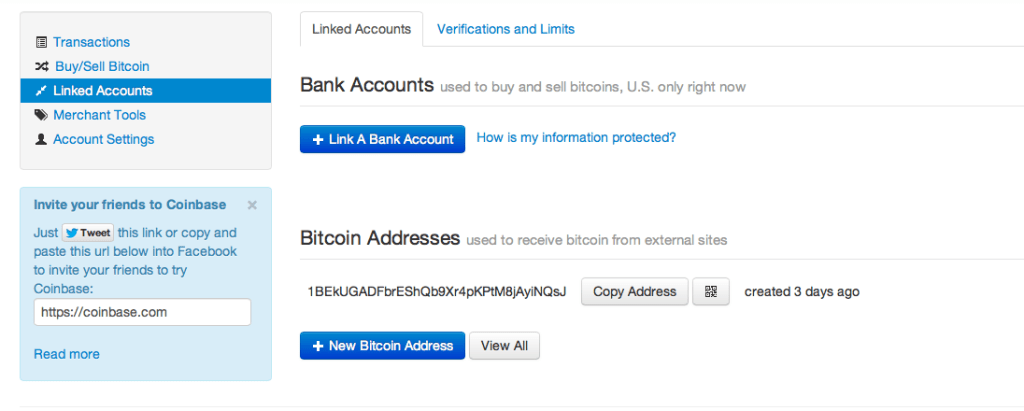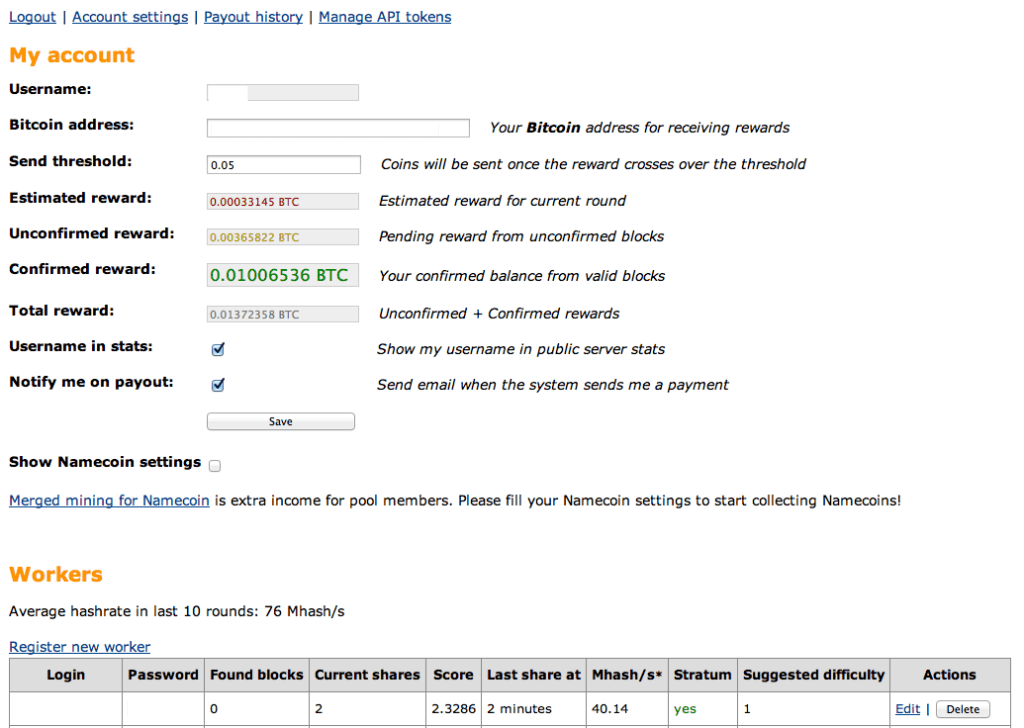1. Obten tu billetera virtual.
Podrias almacenar tus bitcoins localmente en una computadora o bien puedes almacenarlos tambien en un servidor remoto o en linea en Coinbase.com por ejemplo que es una billetera en linea que es sorprendemente facil, pero requieres tener un archivo grande, el archivo de la cadena de bloques, de unos 6GB – Como cualquier otro medio de almacenanmiento, mantener los bitcoins de forma local, quiza podria ser mas seguro que confiar en un servicio en liena. pero es un asunto de preferencia personal, -There is no preferred wallet type and there are obvious trade-offs to both. Privacy advocates would probably say a local wallet is best.
You can download a local wallet here but make sure you keep a copy of your data backed up.
Once you’ve created a wallet, you get an address like this: 1BEkUGADFbrEShQb9Xr4pKPtM8jAyiNQsJ. This, without the period, is a direct way to send bitcoins to your wallet. Make a note of your address. In Coinbase, the wallet address found under linked accounts.

2. Join a pool.
To mine in a pool you have to work with a group of other miners on available blocks. The most popular is Slush’s Pool found here. You can also try guilds like BTC Guild as well as a number of other options. Each of the pools is characterized mostly by the fees they charge per block – 2% for Slush’s pool, for example – and the number of users. Pools with fewer users could also have a slower discovery time but pools with many users usually result in smaller payments.
How can you be sure the pool owner doesn’t steal all your bitcoins? You can’t. However, as one pool owner, Slush, notes:
In
theory, as the Bitcoin pool operator, I could keep the 25 BTC from a
block found by the pool for myself. I’m not going to do this, but I
completely accept that people do not trust the pool operator. It is
their freedom of choice, and Bitcoin is about freedom.
For simplicity’s sake, I’m using Slush’s Pool and have created three
workers. First, create a pool login. Then add workers. The workers are
sub-accounts with their own passwords and are usually identified by
[yourlogin].[workername]. I have three workers running, currently – one
on my iMac and two on my old PC.
You must create workers to mine. The instructions are very straightforward for most services so don’t become overwhelmed. Like any online club, you can dig deeply into the subculture surround bitcoin as you gain experience. I like to think of it as a financial MMORPG.
Also be sure to enter your wallet address into the pool information. This will ensure you get your bitcoins.
3. Get a miner. There are a number of mining options for multiple platforms although OSX users may find themselves in a bit of a pickle. Miners use spare GPU cycles to power the mining operation, much like services like SETI@Home uses spare cycles for finding intelligent life. Miners, on the other hand, use these cycles to help handle peer-to-peer processes associated with bitcoins. Thus by doing “work” you are maintaining the network as well.
GUIMiner is the simplest solution for Windows users as it allows you to create miners using almost all standard graphics cards. You can download it here. 50Miner is also a popular solution. Both require you to enter your worker info and pool and they’ll start mining.
Linux users can run miners like CGMiner. An excellent guide to installing a miner on Ubuntu is available here.
OS X users can use DiabloMiner, a two-year old command-line program that will mine using OpenCL. Sadly, it uses deprecated calls to Bitcoin and is quite a bit slower. As a result, you need to run your own proxy, Stratum, that allows Diablo to connect with services like Slush’s pool. Both of these programs usually run without issue on OS X although you may need to install OpenCL for OSX.
To mine I’ve created a script that I run in Terminal that simply runs the proxy in the background and then connects Diablo. Note the last two arguments are necessary for Mountain Lion.
./stratum-mining-proxy-master/mining_proxy.py &
./DiabloMiner-OSX.sh -u WORKERNAME -p WORKERPASSWORD -o localhost -r 8332 -w 64 -na
RPCMiner
is far easier to run – you simply click an icon and enter some data –
and both have very rudimentary, text-based interfaces. Running Diablo on
my iMac has not had much effect on application performance under OS X
although it does slow down my Windows 8 machine considerably../DiabloMiner-OSX.sh -u WORKERNAME -p WORKERPASSWORD -o localhost -r 8332 -w 64 -na
4. Keep your mind on your money.
Bitcoins son baffling son simplemente faciles de usar y de minar, los especuladores entonces simplemente pondran muchos trabajadores a hacer mineria, en teoria el sistema fue diseñado para evitar esta injusticia, haciendo que cada vez sea mas dificil de hacer mineria.
No hay comentarios:
Publicar un comentario